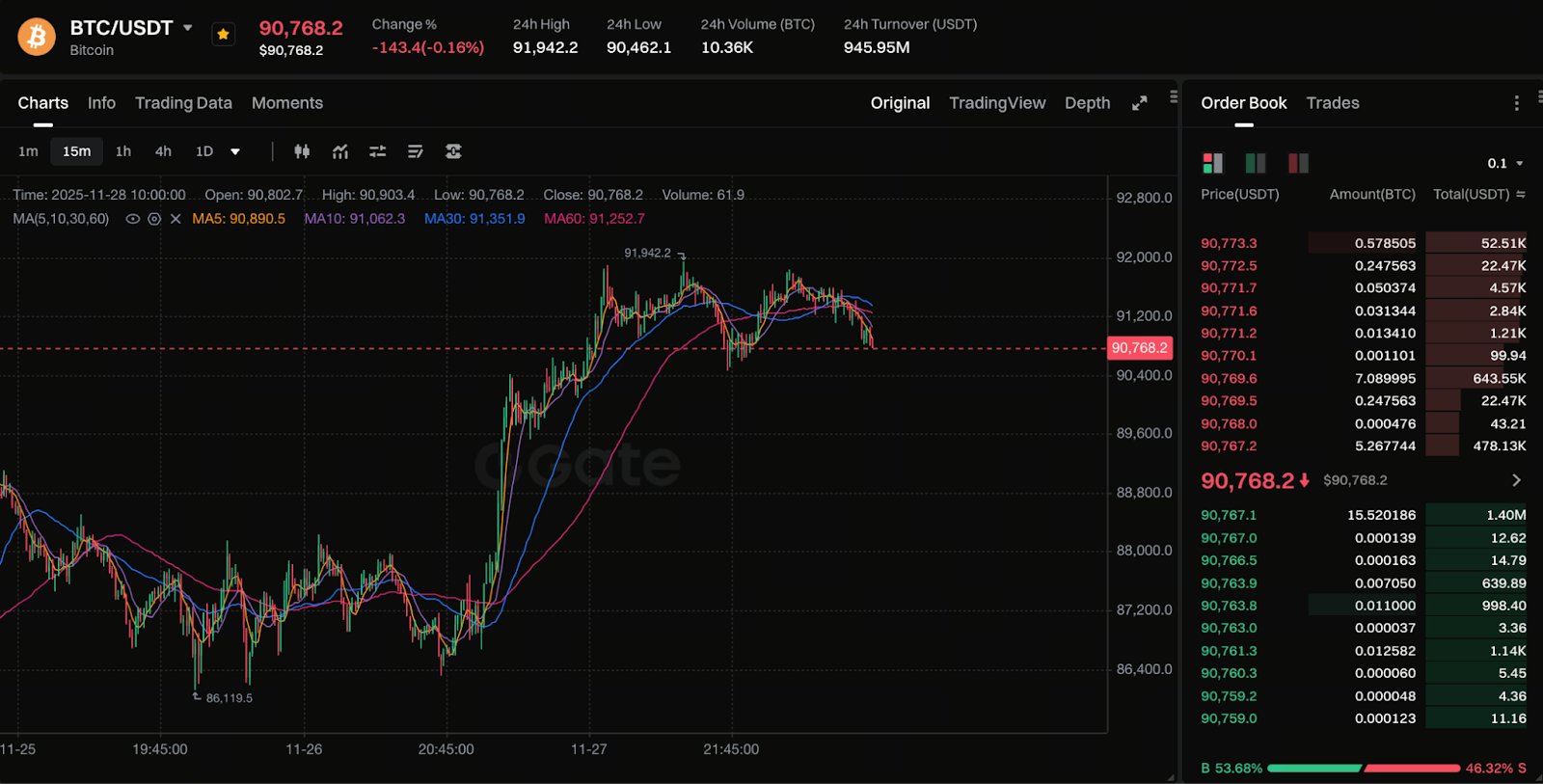Bull Market Return? Bitcoin Rebounds Back to $90,000 — Did You Buy the Dip?

Image: https://www.gate.com/trade/BTC_USDT
After several weeks of sideways volatility, Bitcoin staged a powerful comeback by rebounding quickly from its recent low near $80,000 and repeatedly testing and holding above the $90,000 threshold. This surge sparked intense market debate: Is the bull market about to reignite?
Meanwhile, “Did you buy at the bottom?” has become the most common question in the community.
To make sense of this rally, we need to break down the changes happening in the market from several angles.
Bitcoin Reclaims $90,000: Latest Market Action and Rebound Drivers
Bitcoin surged 8%–12% in just a few days in late November 2025, reaching an intraday high of nearly $91,000 and fully recovering prior losses to set a new rebound peak.
Several core factors fueled this price move:
- Before the rebound, the market faced persistent selling pressure and waves of panic.
- Capital flows shifted from panic-driven selling to aggressive buying at lower levels.
- Long-term holders not only maintained their positions but actually increased their holding periods.
This dynamic triggered a short-term rapid rally, with prices accelerating sharply in a short window.
Three Key Drivers Behind the Rebound
While the rally may seem sudden, it’s driven by clear underlying logic:
1. Improved macro outlook and renewed risk appetite: The market is once again betting on a shift to looser monetary policy, with expectations for increased global liquidity. In this environment, Bitcoin—as a risk asset—typically leads the response.
2. Short squeeze accelerates the move: A large build-up of speculative shorts at lower levels set the stage. As Bitcoin rallied and broke through key resistance, the following unfolded:
- Short sellers were forced to cover
- Algorithmic trading systems triggered buybacks
- Liquidations of leveraged shorts drove prices even higher
The result: a sharp rally that propelled the price upward at an unusually fast pace.
3. Medium- and long-term buyers find value in the current price range: Institutions, long-term holders, and major players increased their positions during the decline, reinforcing the bottom.
Did You Really Buy the Bottom? Insights from Data and Sentiment Analysis
Many investors wonder: “Did I buy at the bottom?” In reality, bottoms are only clear in hindsight. However, a few indicators can help you gauge whether you entered near a bottom:
1. Sentiment hits extreme pessimism: Most investors exit in panic, while long-term capital steps in—typically a sign the bottom is near.
2. On-chain data shows increased concentration of holdings: This means buyers are willing to hold at higher prices rather than waiting for a deeper drop.
3. Large transfers and long-term wallet balances continue to increase: This signals strong conviction buying. If you purchased during a sharp sell-off amid overwhelmingly negative sentiment, you are likely closer to the bottom zone than most investors.
Is the Bull Trend Back? Key Resistance and Future Risks
Despite clear positive signals, confirming a full bull market recovery requires watching critical levels and conditions.
Key resistance: The $95,000 to $100,000 zone is a major psychological barrier and a dense cluster of prior positions. Only a decisive break above this range would open the door to higher targets.
Potential risk factors:
- Negative macro news could quickly cool the market
- Excessive leverage could trigger renewed volatility
- Large profit-taking could spark a significant pullback
While the rebound is robust, a confirmed bull market still needs more time and a sustained uptrend.
Investor Strategy: How to Avoid Chasing Highs and Panic Selling
- Avoid going all-in during periods of extreme optimism
- Staggered entries are always safer than a single large purchase
- Set clear take-profit and stop-loss levels
- Medium- and long-term investors should focus on broader trends rather than short-term swings
If you already bought at lower levels, congratulations on your entry. If you’re still on the sidelines, stay patient—waiting for a pullback or confirmation is much wiser than blindly chasing the rally.
Related Articles

Pi Coin Transaction Guide: How to Transfer to Gate.com

Flare Crypto Explained: What Is Flare Network and Why It Matters in 2025

2025 BTC Price Prediction: BTC Trend Forecast Based on Technical and Macroeconomic Data

How to Use a Crypto Whale Tracker: Top Tool Recommendation for 2025 to Follow Whale Moves

What is N2: An AI-Driven Layer 2 Solution
